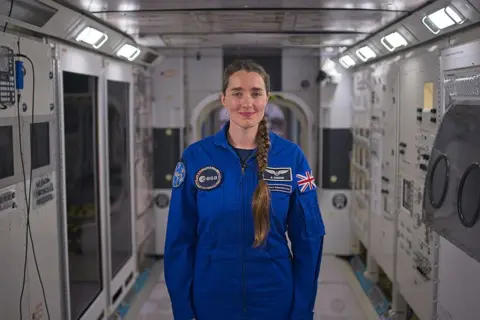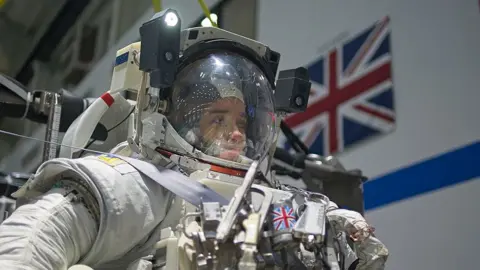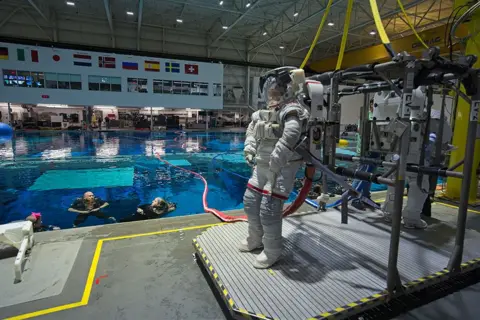Rosemary Coogan is surrounded by a team of people pushing, pulling, squishing and squeezing her into a spacesuit.
It takes about 45 minutes to get all her gear on before a helmet is carefully lowered over her head.
The British astronaut is about to undergo her toughest challenge yet – assessing whether she is ready for a spacewalk. The test will take place in one of the largest pools in the world: Nasa’s Neutral Buoyancy Laboratory at the Johnson Space Center in Houston, Texas.
The pool – which is 12m deep (40ft) – contains a life-sized replica of the International Space Station (ISS), and a “spacewalk” here is as close as it gets to mimicking weightlessness on Earth.
 Kevin Church/BBC
Kevin Church/BBC“It’s a big day,” Rosemary says before the dive, which is going to last more than six hours. “It’s very physically intense – and it’s very psychologically intense.”
But Rosemary doesn’t seem too fazed. She smiles and waves as the platform she’s standing on is slowly lowered into the water.
Being an astronaut was Dr Rosemary Coogan’s dream from a young age, she says. But it was a dream that seemed out of reach.
“At the careers day at school, you don’t tend to meet astronauts,” Rosemary says. “You don’t get to meet people who’ve done it, you don’t really get to hear their stories.”
So she decided to study the stars instead, opting for a career in astrophysics. But when the European Space Agency (ESA) announced it was looking for new recruits to go to space, Rosemary applied and was chosen from more than 22,000 people.
 Kevin Church/BBC
Kevin Church/BBC Kevin Church/BBC
Kevin Church/BBCESA aims to get Rosemary to the International Space Station (ISS) by 2030. She’ll be following in the footsteps of Britons Helen Sharman, who visited the Soviet’s Mir Space Station in 1991, and Tim Peake who launched to the ISS in 2015.
Rosemary has spent the last six months training at the Johnson Space Center. As well as exploring the outside of the submerged ISS, she can head inside the orbiting lab in another life-sized mock-up located in a huge hangar.
She takes us on a tour of the lab’s interconnected modules. It feels very cramped, especially considering astronauts usually spend many months on board. But Rosemary reminds us about the spectacular views.
“It is an isolated environment, but I think this helps to give that kind of connection to being outside – to alleviate that sense of claustrophobia.”